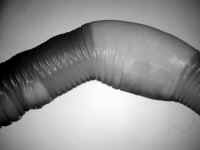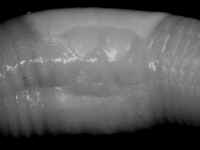Aporrectodea caliginosa (Savigny, 1826)
Description - External - Body length 50
-150 mm, diameter 2-4 mm, 100
-180 segments. Colour usually br own,
sometimes greenish. Some pigmentation almost always present, at least dorsad at
the front of the body. Head epilobous, first dorsal pore between 5/6-9/10
. Glandular tumescence usually on (9)10 -12 ab.
Setae closely paired, setal arrangement after the clitellum: aa:ab:bc:cd:dd=
x:x:x:x:x. Clitellum extends on segments 25, 26, (29)-34, 35 saddle-shaped.
Tubercles on 31-33 as two pair of scale-like protuberances, or a continuous
pad-like organ, but all of the transitory stages could be fund. Male pore on 15,
great slit between setae b-c, surrounded by a glandular crescent,
frequently protruding into the neighboring segments.
own,
sometimes greenish. Some pigmentation almost always present, at least dorsad at
the front of the body. Head epilobous, first dorsal pore between 5/6-9/10
. Glandular tumescence usually on (9)10 -12 ab.
Setae closely paired, setal arrangement after the clitellum: aa:ab:bc:cd:dd=
x:x:x:x:x. Clitellum extends on segments 25, 26, (29)-34, 35 saddle-shaped.
Tubercles on 31-33 as two pair of scale-like protuberances, or a continuous
pad-like organ, but all of the transitory stages could be fund. Male pore on 15,
great slit between setae b-c, surrounded by a glandular crescent,
frequently protruding into the neighboring segments.
Internal - Dissepiments 5/6-9/10
moderately thickened. Crop in 15-16, gizzards in 17-18. Two pairs of testes free
in 10 , 11, and four pairs of seminal
vesicles in 9-12. Receptaculae seminis two pairs in 9/10
, 10 /11 open in setal line cd.
Calciferous glands in 10 -12 with lateral
pouches in 10 . Excretory system
holonephridial with "S" shaped nephridial bladders, hook backwards.
The cross section of longitudinal muscle layer are of pennate type.
This species is one of the most widely distributed earthworm
with different partenogenetic and polyploid morphs described as separate
species.
Distribution - Ap. caliginosa is a typical
synanthrop species. It thrives in pastures, gardens and forest as well. It could
be found in every type of substrate even in the poorest sandy soil. As adapted
to live in a disturbed environment it could displace native worms if introduced.
According to the Bouche's ecological characterization Ap. caliginosa
belongs to the endogeic group, living and feeding in the mineral soil layer.
This species is native in the Palearctic, but it has been introduced
extratropically all over the world.
 own,
sometimes greenish. Some pigmentation almost always present, at least dorsad at
the front of the body. Head epilobous, first dorsal pore between 5/6-9/10
. Glandular tumescence usually on (9)10 -12 ab.
Setae closely paired, setal arrangement after the clitellum: aa:ab:bc:cd:dd=
x:x:x:x:x. Clitellum extends on segments 25, 26, (29)-34, 35 saddle-shaped.
Tubercles on 31-33 as two pair of scale-like protuberances, or a continuous
pad-like organ, but all of the transitory stages could be fund. Male pore on 15,
great slit between setae b-c, surrounded by a glandular crescent,
frequently protruding into the neighboring segments.
own,
sometimes greenish. Some pigmentation almost always present, at least dorsad at
the front of the body. Head epilobous, first dorsal pore between 5/6-9/10
. Glandular tumescence usually on (9)10 -12 ab.
Setae closely paired, setal arrangement after the clitellum: aa:ab:bc:cd:dd=
x:x:x:x:x. Clitellum extends on segments 25, 26, (29)-34, 35 saddle-shaped.
Tubercles on 31-33 as two pair of scale-like protuberances, or a continuous
pad-like organ, but all of the transitory stages could be fund. Male pore on 15,
great slit between setae b-c, surrounded by a glandular crescent,
frequently protruding into the neighboring segments.